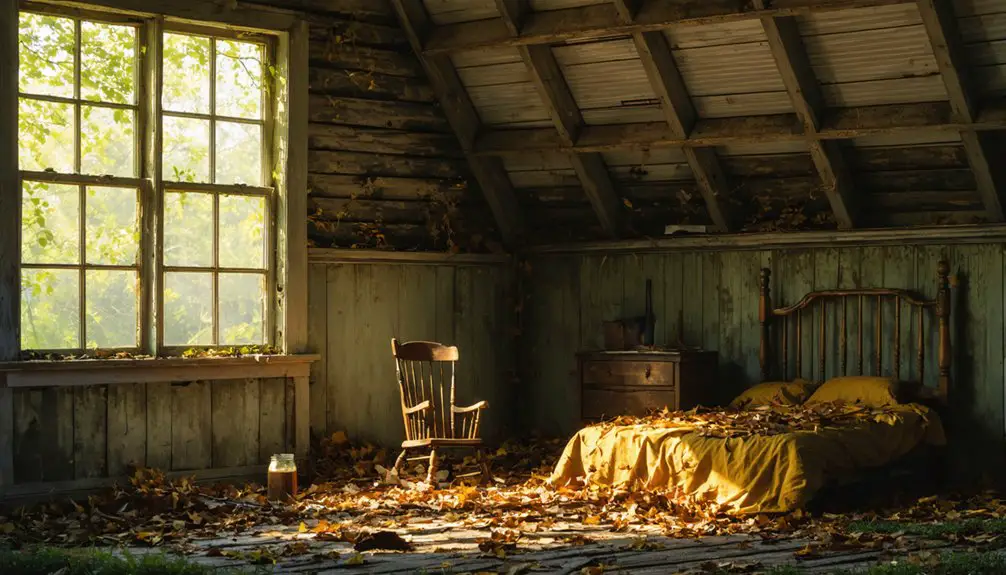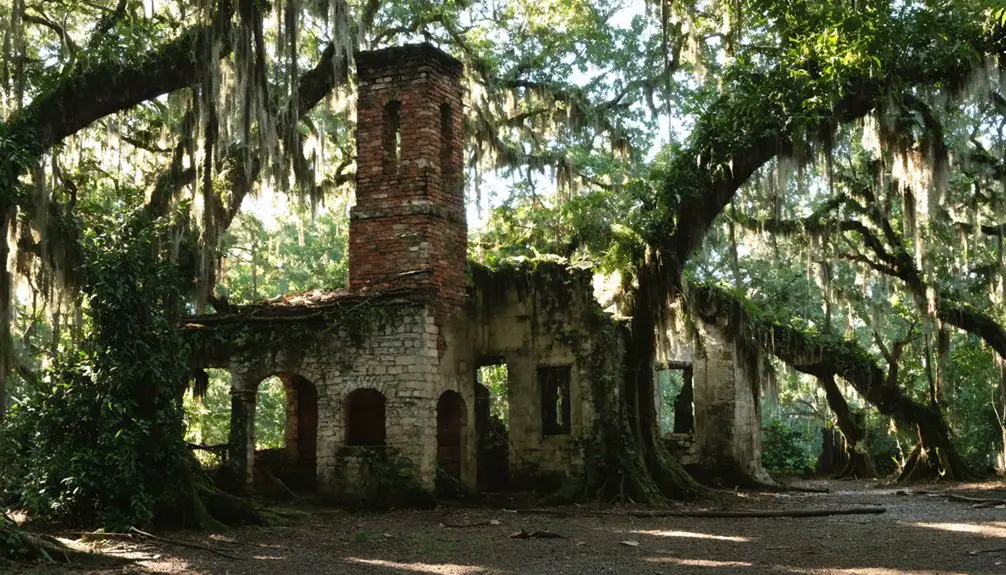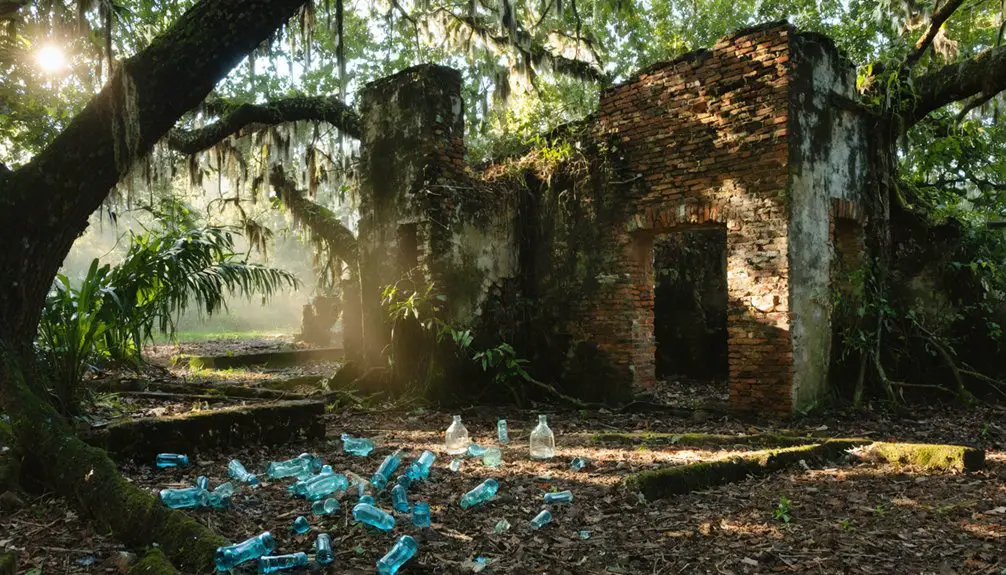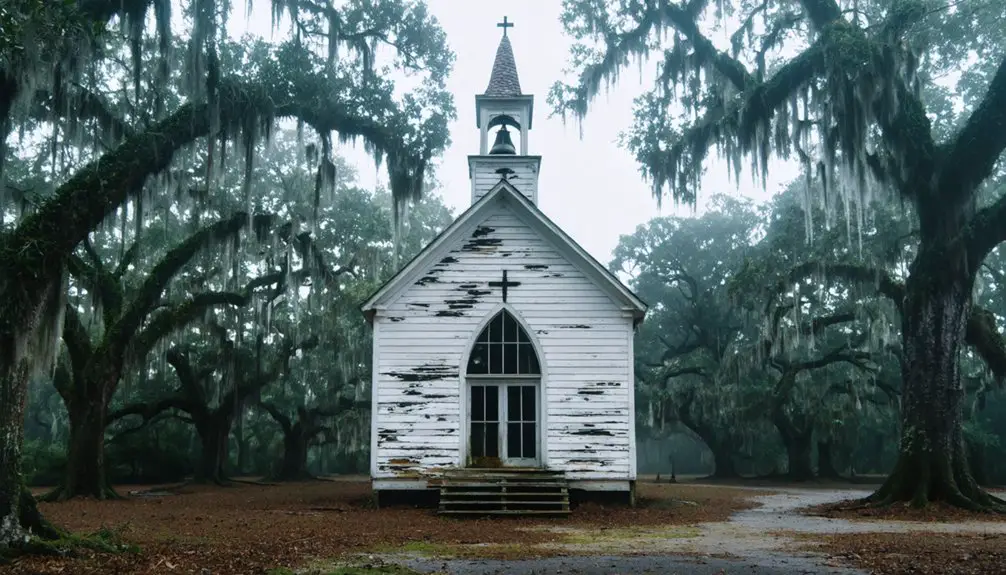You’ll find Bereah’s remains about 10 km northwest of Avon Park, Florida, where late 19th-century pioneer families established a thriving farming community. The settlement flourished through agriculture, with notable crops including sisal hemp, celery, and strawberries. Though economic challenges and isolation led to its abandonment, you can still visit the historic Corinth Primitive Baptist Church cemetery, containing over 579 memorial records. The ghost town’s rich history holds many more fascinating secrets beneath its grove trees.
Key Takeaways
- Bereah emerged as a farming and ranching settlement in Polk County during the late 19th century before becoming a ghost town.
- The community declined due to poor transportation infrastructure, agricultural mechanization, and population shifts toward urban areas.
- Corinth Primitive Baptist Church cemetery remains a key landmark, containing over 579 memorial records of the town’s history.
- Located at 27.65556°N, 81.62361°W, approximately 10 kilometers northwest of Avon Park, Florida, near County Line Road.
- The town’s agricultural legacy included sisal hemp cultivation, truck farming operations, and cattle ranching before its abandonment.
Mapping Bereah’s Lost Landscape
How do you map a town that has virtually disappeared from the landscape? To find Bereah, you’ll need to piece together both modern and historical evidence. The ghost town‘s location, at 27.65556°N, 81.62361°W, lies about 10 kilometers northwest of Avon Park, Florida.
Mapping a vanished town requires detective work, piecing together clues from the past to reveal Bereah’s ghostly footprint in Florida.
While most structures have vanished, the Corinth Primitive Baptist Church cemetery remains as an essential landmark. Similar to the Hampton Springs Hotel site, archaeological excavations could reveal valuable information about building foundations and settlement patterns.
You’ll face significant archaeological challenges when mapping this lost community. Natural reclamation has obscured many surface features, and vegetation now dominates where buildings once stood.
Modern reference points include County Line Road, while local folklore of ghost lights along Bereah Road adds intrigue to the site. Visitors frequently report seeing unexplained spectral phenomena in the area. By combining GPS coordinates, historical maps, and surviving landmarks, you can trace the footprint of this vanished settlement.
Early Settlement and Name Origins
Bereah emerged in the late 19th century as a farming and ranching settlement approximately 10 kilometers northwest of modern-day Avon Park in Polk County, Florida.
You’ll find that pioneer families chose this location for its agricultural potential, establishing homesteads that would support generations of farming operations. The settlement’s population growth trends mirrored those seen in Center Hill, which expanded from under 1,000 to 1,500 residents within eight years.
While the exact origin of the name “Bereah” remains unclear, it’s likely derived from biblical references common to Florida settlements of that era, though it occasionally appears as “Bareah” in some historical records. The area gained notoriety in the 1950s for its mysterious Bereah Ghost Light that appears nightly at the intersection of West Bereah Road and County Line Road.
Original Name and Evolution
While historical records provide limited information about its origins, the small community of Bereah emerged in Polk County, Florida during the late 19th to early 20th centuries.
Located northwest of Avon Park, the settlement’s historical significance lies in its distinctive name, though its cultural influences remain largely undocumented. Early settlers included farmers and timber workers who helped establish the community’s foundation. Much like other ghost towns of the era, the community declined after resources were depleted and industry moved elsewhere.
The evolution of Bereah’s identity can be traced through these key aspects:
- The name “Bereah” appears to have been the settlement’s original designation, with no recorded previous names.
- The community developed around local landmarks, including the Corinth Primitive Baptist Church cemetery.
- The name may have biblical origins, similar to other regional settlements that drew inspiration from religious references.
You’ll find that unlike many Florida ghost towns, Bereah’s documented history remains particularly sparse.
Settlement Location Selection
In selecting the location for their new settlement, early pioneers were drawn to a promising site in Polk County, approximately 10 kilometers northwest of Avon Park. The settlement patterns revealed strategic thinking, as they chose land that offered abundant timber resources and fertile soil for farming and ranching activities.
The geographic significance of Bereah’s location at 27°39′20″N 81°37′25″W provided essential advantages. You’ll find that the early settlers positioned themselves near vital railroad infrastructure, enabling trade connections with regional markets.
They also valued the area’s water sources, which supported both residential and industrial needs. However, these same water features would later prove challenging, as recurring floods threatened the community’s infrastructure, much like the devastating 1905 flood damage that destroyed Farr’s Bridge.
The proximity to larger towns like Avon Park enhanced the settlement’s potential as a viable community hub. The community’s eventual decline led to its current status as a Florida ghost town, reflecting the changing patterns of settlement in the region.
Early Pioneer Families
Several prominent pioneer families laid the foundation for Bereah’s early development, including the Ben Hill Griffin family, known for their agricultural contributions and the donation of an 1800s corn crib barn to Cracker Country.
Pioneer contributions from families like the Allens, who arrived in the late 1820s, helped establish essential community institutions. Council B. Allen and his family settled along the Ochlocknee River, making significant improvements to the surrounding wilderness lands. Many families sought better opportunities in Florida after facing poverty and destruction in other Southern states following the Civil War. The settlement challenges they faced required determination and resourcefulness to overcome the untamed Florida wilderness.
Early settlers shaped Bereah’s identity through:
- Religious foundations – establishing churches like Bethel Church around 1834
- Agricultural development – creating sustainable farming practices and infrastructure
- Community leadership – serving as trustees and caretakers of shared properties
The Fontanet/FONTANE family and others who arrived before Florida’s statehood in 1845 contributed considerably to the area’s cultural fabric, laying groundwork for future generations.
Rise of Agricultural Commerce
The agricultural landscape of South Florida underwent dramatic transformation during the mid-19th century, starting with significant sisal hemp cultivation near the Charles Deering estate.
You’d find nearly 6,000 sisal hemp plants thriving despite challenging swampy conditions, marking early agricultural innovation in the region.
As railway expansion reached the area, you’ll see how commerce growth accelerated rapidly.
Black families from the Panhandle and Bahamas became pioneering landowners in Delray Beach by 1894, while farmers like Adolf Hofman introduced lucrative truck farming operations.
They’d grow celery, cabbage, tomatoes, and strawberries, shipping them north via the new Florida East Coast Railway.
Though early freezes posed challenges, the introduction of drainage systems and canals transformed previously unsettled land into productive farmland, setting the stage for South Florida’s agricultural boom.
The Corinth Primitive Baptist Legacy

You’ll find the Corinth Primitive Baptist Church‘s legacy etched into Bereah’s landscape through its historic cemetery, which preserves the names and stories of the town’s earliest settlers.
The church’s sacred grounds, established in 1893, stood as a symbol of the rural Baptist community’s commitment to simple, traditional worship practices typical of the Wiregrass Primitive Baptist tradition.
The congregation’s emphasis on autonomous faith and conservative values reflected the deep-rooted Baptist heritage that characterized many small agricultural communities across north Florida and southern Georgia during this era.
Cemetery Preserves Town History
Standing as one of Bereah’s last physical remnants, Corinth Primitive Baptist Cemetery chronicles the ghost town’s rich history through its 579 memorial records and sacred grounds.
The cemetery’s historical narratives reveal the evolution of this rural community from its origins in Hillsborough County through Polk County’s formation in 1861.
Through cemetery symbolism and carefully preserved records, you’ll discover:
- Prominent families like the Altmans, Pollards, and Raulersons who shaped Bereah’s development
- Evidence of local industries including mining and moonshine operations that sustained the town until the 1950s
- The spiritual legacy of the Primitive Baptist Church, established in 1893, which served as the community’s religious center
These grounds remain an essential link to understanding Bereah’s transformation from a thriving town to its current ghost town status.
Church’s Enduring Sacred Ground
Established in 1893, Corinth Primitive Baptist Church served as more than just a religious institution – it became the beating heart of Bereah’s tight-knit community.
You’ll find the church’s architecture reflects the traditional wooden styles common to rural Florida’s Primitive Baptist congregations of that era.
As Bereah’s central gathering place, the church preserved sacred traditions through monthly meetings, baptisms, and funerals.
Prominent families like the Altmans, Pollards, and Johnsons strengthened their bonds through community gatherings here.
While the surrounding town has faded into history, the church grounds remain consecrated, housing over 579 memorials in its cemetery.
Even today, this historic structure stands as a symbol of the religious values and self-sustaining spirit that defined Bereah’s rural Baptist population.
Baptist Community’s Rural Roots
While the Wiregrass region’s Primitive Baptist movement flourished throughout South Georgia and Florida, Corinth Primitive Baptist Church emerged as a cornerstone of Bereah’s rural identity in 1881.
You’ll find the church’s Baptist heritage deeply intertwined with pioneering families like the Altmans, Pollards, and Raulersons, who shaped the area’s spiritual landscape.
The rural congregation’s story unfolds through:
- Their autonomous worship practices that reflected conservative Baptist traditions
- A tight-knit community sustained by farming, mining at Old Colony Mine, and even moonshine production until the 1950s
- A sacred cemetery that chronicles generations of faithful members who maintained their religious customs
This enduring Baptist presence carried the community through economic shifts while preserving their independent spiritual values.
Daily Life in Rural Polk County

As settlers arrived in Polk County after 1842, they quickly established a rural lifestyle centered around farming, ranching, and small community institutions.
You’d find families cultivating staple crops and orange groves, while ranchers grazed cattle across the southern plains. Rural traditions revolved around one-room schoolhouses, churches, and shared labor during harvests and cattle drives.
Daily travel was challenging – you’d spend hours by horse or buggy just to cover 14 miles.
Until the railroad’s arrival in 1884, you’d rely on shallow wells for water and animal power for farming.
Community resilience showed through joint efforts to build schools and churches, particularly in African American settlements like Moorehead, where residents created their own institutions despite facing segregation and violence.
Economic Decline and Abandonment
Once Bereah’s local economy depended heavily on family farms and ranches, you’d find its prosperity tied closely to agricultural markets and regional trade with towns like Avon Park.
Without major transportation infrastructure like railroads, the town’s economic resilience weakened as agriculture modernized and markets shifted.
You’ll recognize three key factors that led to Bereah’s abandonment:
- Agricultural mechanization and falling crop prices made small family farming less viable
- Limited transport connections isolated the community from profitable trade routes
- Population shifts toward urbanized areas drained the workforce and local spending power
The lack of economic diversification meant you couldn’t find enough jobs to sustain the community.
As residents moved away seeking better opportunities, local businesses closed and Bereah gradually transformed into the ghost town you’d see today.
Hidden Among the Grove Trees

Located approximately 10 kilometers northwest of Avon Park, the abandoned townsite of Bereah lies concealed within dense orange groves that form a natural barrier around its remains.
You’ll find the Corinth Primitive Baptist Church cemetery nestled among the subtropical flora, while an old railroad right-of-way cuts through the property.
The grove’s thick vegetation has contributed remarkably to the site’s mysterious reputation, spawning numerous ghostly sightings and folklore origins since the 1950s.
Local legend tells of a floating orb, about two feet in diameter, that hovers five feet above ground near the former railroad line.
This “ghost light,” believed to be the spirit of a deceased conductor, reportedly moves away when approached, adding to Bereah’s mystical atmosphere.
Notable Families and Community Leaders
While establishing their roots in Bereah during the town’s early years, prominent families like the Crews shaped the community through farming, ranching, and religious leadership.
The town’s community dynamics revolved around agricultural cooperation and religious fellowship, with the Corinth Primitive Baptist Church serving as the central gathering place.
Key leadership roles emerged through:
- Church elders who guided spiritual life and mediated community decisions
- Family patriarchs who organized farming schedules and managed shared resources
- Landowners who participated in regional agricultural associations and trade networks
These influential families maintained social stability through kinship ties and informal governance.
Their economic impact extended beyond Bereah’s boundaries as they brokered trade deals with neighboring towns like Avon Park, while their descendants continued agricultural traditions even after the town’s decline.
Archaeological Evidence and Remnants

Archaeological investigations of Bereah reveal a historic cemetery as the town’s primary surviving remnant, with legible headstones dating back to the 1890s.
You’ll find the cemetery protected by wire fencing to shield it from vehicle traffic and preserve the burial site from encroaching vegetation.
The cemetery contains grave markers for both adults and children, offering insights into the community’s demographics.
Gravestones of adults and children in Bereah’s cemetery paint a portrait of the town’s past population and family structures.
While the headstones range from intact monuments to weathered stones, they’re valuable indicators of local burial practices and family relationships.
Unlike other Florida ghost towns that often feature shell rings or extensive structural remains, you won’t find many physical traces of Bereah’s buildings.
Adjacent areas may contain unmarked graves, possibly belonging to residents who couldn’t afford formal plots in the main cemetery.
Preserving the Town’s Memory
You’ll find rich historical records of Bereah’s past through cemetery documentation at sites like the Corinth Primitive Baptist Church cemetery, where grave markers tell stories of the town’s earliest settlers.
Local historians have gathered oral histories, photographs, and written accounts that preserve details about daily life in this once-thriving community.
Physical artifacts discovered in the area, along with documented family histories maintained by historical societies, continue to provide tangible connections to Bereah’s legacy.
Cemetery Records Tell Stories
The records left behind in Bereah’s cemetery tell a compelling story of the town’s past residents.
You’ll find the most tangible evidence of the community’s history in the Corinth Primitive Baptist Church burial grounds, where cemetery symbolism and burial traditions reveal intimate details about those who once called this place home.
Walking through these grounds, you’ll discover:
- Headstone inscriptions that document family names, death dates, and sometimes occupations
- Family plot arrangements that map relationships and migration patterns
- Marker materials and styles that reflect the economic conditions of different time periods
While wooden crosses have largely deteriorated and metal markers have rusted, the cemetery’s remaining features help reconstruct Bereah’s demographic makeup, serving as an essential historical archive for future generations.
Local Historians Document Past
While Bereah’s physical structures have largely vanished, dedicated local historians work tirelessly to preserve the town’s memory through systematic documentation efforts.
You’ll find their meticulous research combining oral traditions with archival records, mapping coordinates, and analyzing old land deeds to piece together historical narratives of this lost community.
Local museums and historical societies, like the Bartow Historical Society, collaborate to maintain thorough records while distinguishing fact from folklore.
They’ve gathered stories from descendants, documented the mysterious “ghost light” phenomenon, and preserved photographs of remaining landmarks.
Through careful navigation of private property laws and trespassing restrictions, researchers continue accessing cemetery grounds and church sites.
You can now explore digitized documents, view curated exhibits, and attend public presentations that bring Bereah’s past to life.
Community Artifacts Still Remain
Despite Bereah’s abandonment, significant physical remnants offer tangible connections to this vanished Florida community. You’ll find artifacts of significance throughout the area, with community connections preserved in the Corinth Primitive Baptist Church cemetery’s headstones and structural foundations.
Today, you can explore three key types of remnants:
- Agricultural artifacts and old farming equipment that showcase the town’s ranching heritage
- Residential foundations and building fragments that map the original town layout
- Historic transportation routes linking Bereah to neighboring communities like Avon Park
Local preservation efforts continue protecting these essential pieces of history from decay and vandalism. Through documented artifacts and careful conservation, you’re able to piece together the story of this once-thriving rural community, keeping its memory alive for future generations.
Frequently Asked Questions
What Role Did Native Americans Play in the Area Before Bereah’s Settlement?
You’d hardly believe the rich tribal history that once thrived here – Native Americans built complex societies, mastered wetland resources, and left lasting cultural impact through their trade networks and agricultural practices.
Were There Any Schools or Educational Facilities Established in Bereah?
You won’t find any documented schools or educational facilities in Bereah’s educational history. Kids likely attended classes in nearby towns, as there’s no evidence of school architecture in this settlement.
What Was the Peak Population of Bereah During Its Most Prosperous Years?
You won’t find exact peak population figures for this ghost town. Demographics suggest it likely housed between 100-500 residents during population growth, based on typical patterns of similar rural Florida settlements.
Did Any Significant Transportation Routes or Railroads Connect Through Bereah?
Despite extensive research into transportation history, you won’t find any confirmed railroads or major routes through Bereah. The town’s isolation from significant transportation corridors likely contributed to its eventual decline.
What Natural Disasters or Extreme Weather Events Affected Bereah Historically?
You’d find devastating hurricane impacts wreaked havoc on Bereah, especially the 1928 Okeechobee and 1945 Homestead storms. Severe flood events, winter freezes, and persistent stormwater problems ultimately drove residents away.
References
- https://en.wikipedia.org/wiki/Bareah
- https://floridatrailblazer.com/2016/11/15/exploring-oriole-ghost-town-in-withlacoochee-state-forest/
- https://patchproflorida.com/blog/the-fascinating-history-of-floridas-ghost-towns/
- https://www.newspapers.com/article/the-tampa-tribune-bereah-florida-ghost-t/54144614/
- https://www.ghosttowns.com/states/fl/bareah.html
- https://en.wikipedia.org/wiki/List_of_ghost_towns_in_Florida
- https://www.mapspirits.com/properties/ghost-lights-of-bereah-road-in-frostproof-fl/
- https://www.historichotels.org/us/hotels-resorts/the-seelbach-hilton-louisville/weddings.php
- https://ohiofestivals.net/ohio-festivals/
- http://the863magazine.com/previous-issues-of-the-863-magazine/october-2013/haunted-polk-by-james-coulter/



